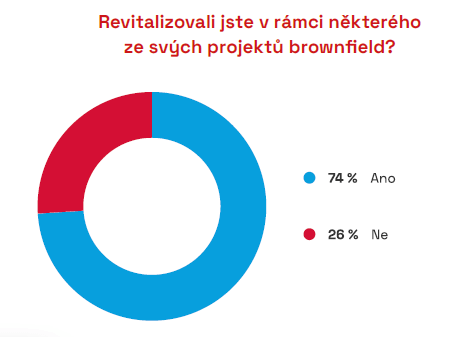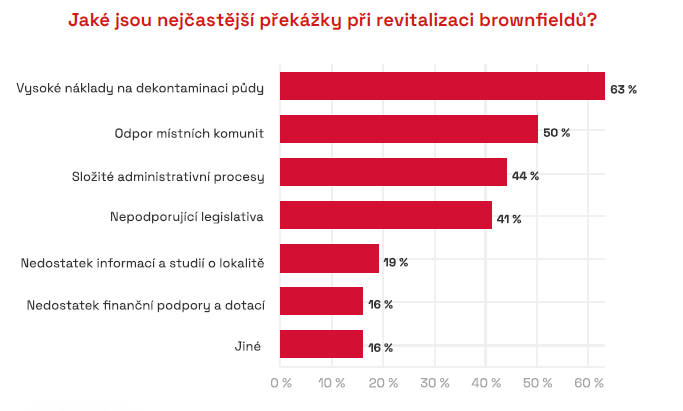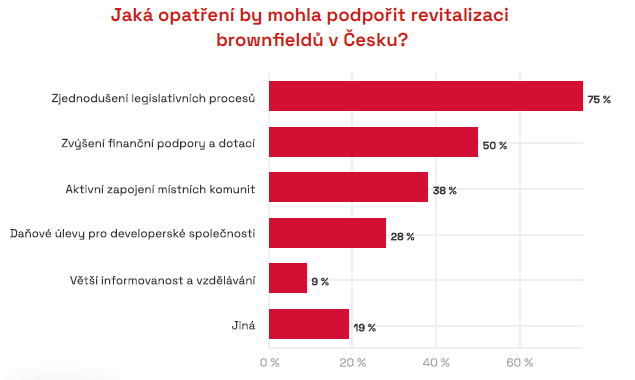Revitalisation of brownfields has become an important part of development activities in the Czech Republic in recent years. Most developers have practical experience with these projects and plan to work with them in the future. Brownfields are often in attractive locations, but their revitalisation is challenging. Despite this, interest in them is steadily increasing because their efficient use brings significant benefits to cities and municipalities. This is according to the H2/2024 Study of property developers published by CEEC Research.
Brownfield revitalisation often presents a challenge but also an opportunity. A large percentage of abandoned or neglected sites are located in attractive urban locations with good infrastructure, which is attractive to developers, 94 % of whom indicated that they would be interested in using brownfield sites for their future projects.
Director of CEEC Research, Michal Vacek He says: "Developers are undoubtedly trying to prepare projects in attractive locations to increase the interest in purchase and their market value. The option of brownfield revitalisation goes hand in hand with the previous arguments, because I see a large amount of such usable areas in large cities such as Prague, Brno, but also others. These are certainly interesting investment opportunities, the revitalisation of which is of interest not only to investors, but also to the owners of these dilapidated plots, which largely include urban districts. This is proven by years of experience."

Construction on the brownfield site must be conceptually integrated into the existing area. The main advantage is seen by 68 % respondents in the use of the already built-up area, which brings an appreciation of the space and its better usability in urban areas. Another significant advantage, according to 19 % respondents, is the improvement of the ecological conditions in the area - the removal of old contaminated buildings and the revitalisation of the soil. This helps to restore the environmental quality of the site. In addition, 10 % developers mention that brownfield redevelopment increases the value of surrounding properties, which can positively impact the entire region.
The most significant obstacles that complicate or slow down brownfield revitalisation include the high cost of land decontamination, resistance from local residents and complex administrative processes.

Soil decontamination was cited as a major barrier by 63 % respondents. Original industrial uses often leave soil contaminated with chemicals or hazardous substances that must be removed by the developer prior to construction. And this is very costly. Developers report that building on brownfields is on average 14 % more expensive than building on greenfields. In addition to decontamination, construction is made more expensive by the demolition of existing buildings and/or technical complications that are common on these sites.
"Due to urban sprawl, these complexes are moving from the periphery to the urban development. These are now locally interesting plots of land, unfortunately, mostly burdened with ecological burdens. So their revitalisation is also leading to the removal of these burdens," Says Lubor Hoďánek, member of the Board of Directors of VPÚ DECO Praha.
In addition, 50 % respondents indicated that they encountered opposition from local residents stemming from concerns about the impact future development would have on the surrounding area. Local councils often have unreasonable financial demands which they justify as offsetting local concerns.
Developers are often faced with bureaucratic obstacles (44 %), the need to change the zoning plan, lack of support from the state or lack of information and studies on the site.
In many European countries, such as the UK and the Netherlands, brownfields are being revitalised thanks to targeted state support, simplified legislative processes and strong local community involvement. In the Czech Republic, similar support is still lacking and developers are mostly hampered by complex legislative processes. According to a survey by CEEC Research, up to 75 % directors of development companies would welcome simplification of legislative processes. An important measure is to increase financial support and subsidies, which would help reduce the costs associated with challenging revitalisation. Involving communities and gaining the support of local residents would also greatly help to speed up projects.

Unfortunately, the situation in the Czech Republic is different than in the above-mentioned European countries. As many as 78 % developers surveyed stated that they do not perceive any state support in the field of brownfields revitalisation. These results suggest that state support in this area is very limited, and thus the development of these projects is significantly slowed down. However, there has been a positive shift in recent years. The state has started to allocate significant funds, for example, under the National Regeneration Plan or through subsidy programmes of the Ministry of Regional Development, which help municipalities and regions to regenerate these areas for business and non-business purposes. Further support is planned through CzechInvest, which has proposed measures for more efficient project implementation, including tax incentives and better preparation of brownfield sites for subsequent investment.
Minister for the Environment Petr Hladik: "I see the comprehensive and systematic preparation of these areas so that they are attractive to investors as an essential tool. This includes resolving property rights, providing the necessary infrastructure and remediating any environmental burdens. It is absolutely essential that the land be quickly re-zoned so that it can be unblocked for construction. Investors need to be assured that projects are not only financially viable, but also environmentally and administratively ready for quick and efficient implementation. Transparent and effective support from the public sector, for example in the form of subsidies or preferential terms, is also a key factor. The Ministry of the Environment regularly offers subsidies for site remediation."
Managing Director of the Smart Facades Centre Pavlína Dvořáková on the use of blighted land says: "Saving space, increasing the attractiveness of the city, investment opportunity - all these are the benefits of brownfields. Pressure to protect undeveloped landscapes is growing, and so naturally investors are looking for opportunities to use old industrial sites. A huge advantage is the use of already built infrastructure, with the associated significant reduction in the cost of using public services. On the other hand, it is necessary to mention the pitfalls associated with this type of construction. The most difficult step is the change of the zoning plan from industrial buildings to mixed use or residential zone. Many building authorities have set long-term strategies for the development of communities, including analyses of the impacts of potential changes. Thus, in a given situation, the intention of the developer may not be compatible with that of the municipality, the city or the region. In the long term, the municipal councils are primarily responsible for the use of brownfields and should create the most favourable conditions for such investments in their spatial plans."
The data is based on Study of development companies H2/2024 prepared by the analytical company CEEC Research, which is published in full on www.ceec.eu.
CEEC Research Helena Grofová/ gnews - RoZ
ILLUSTRATIVE PHOTO - pixabay



